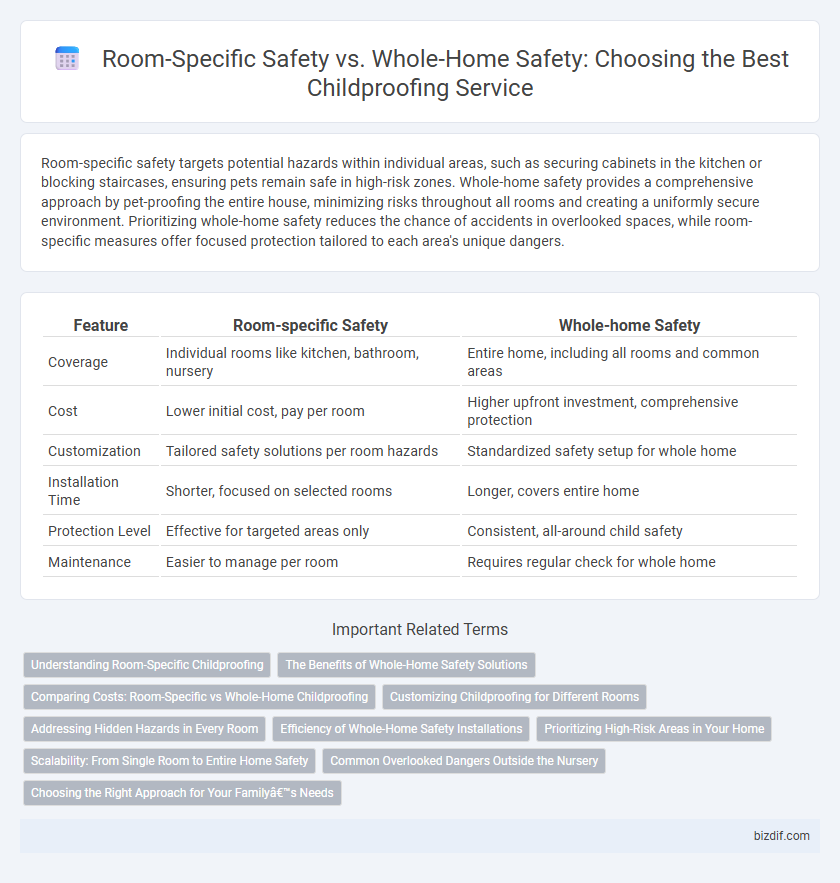Room-specific safety targets potential hazards within individual areas, such as securing cabinets in the kitchen or blocking staircases, ensuring pets remain safe in high-risk zones. Whole-home safety provides a comprehensive approach by pet-proofing the entire house, minimizing risks throughout all rooms and creating a uniformly secure environment. Prioritizing whole-home safety reduces the chance of accidents in overlooked spaces, while room-specific measures offer focused protection tailored to each area's unique dangers.
Table of Comparison
| Feature | Room-specific Safety | Whole-home Safety |
|---|---|---|
| Coverage | Individual rooms like kitchen, bathroom, nursery | Entire home, including all rooms and common areas |
| Cost | Lower initial cost, pay per room | Higher upfront investment, comprehensive protection |
| Customization | Tailored safety solutions per room hazards | Standardized safety setup for whole home |
| Installation Time | Shorter, focused on selected rooms | Longer, covers entire home |
| Protection Level | Effective for targeted areas only | Consistent, all-around child safety |
| Maintenance | Easier to manage per room | Requires regular check for whole home |
Understanding Room-Specific Childproofing
Understanding room-specific childproofing involves identifying unique hazards and implementing targeted safety measures in high-risk areas such as kitchens, bathrooms, and playrooms. This approach ensures the installation of outlet covers, cabinet locks, corner guards, and anti-scald devices, directly addressing potential dangers within individual spaces. Tailoring safety solutions room-by-room enhances overall child protection beyond general whole-home childproofing strategies.
The Benefits of Whole-Home Safety Solutions
Whole-home safety solutions provide comprehensive protection by addressing potential hazards in every room, reducing the risk of accidents throughout the entire living space. These solutions integrate childproofing measures such as outlet covers, cabinet locks, and corner guards to create a seamless barrier against common household dangers. By implementing whole-home safety, parents gain peace of mind knowing their child is safeguarded consistently, not just in isolated areas.
Comparing Costs: Room-Specific vs Whole-Home Childproofing
Room-specific childproofing typically involves targeted investments in high-risk areas like the kitchen or bathroom, resulting in lower upfront costs compared to whole-home safety measures. Whole-home childproofing offers comprehensive protection by installing safety gates, outlet covers, and cabinet locks throughout the house, which increases overall expenses but reduces the need for repeated modifications. Evaluating the cost-benefit balance depends on the child's mobility stage and specific household risks, with whole-home solutions providing long-term savings through enhanced safety and fewer emergency incidents.
Customizing Childproofing for Different Rooms
Customizing childproofing for different rooms addresses unique hazards such as outlet covers in bedrooms, stove guards in kitchens, and cabinet locks in bathrooms. Tailoring safety measures to each room enhances protection by targeting specific risks children encounter in diverse environments. Whole-home safety plans integrate these room-specific solutions to create a comprehensive childproofing strategy.
Addressing Hidden Hazards in Every Room
Room-specific safety targets unique risks in individual spaces, such as securing cabinets in kitchens or covering electrical outlets in living rooms to prevent accidents. Whole-home safety considers comprehensive hazard identification, including hidden dangers like loose wiring or unstable furniture across all rooms. Addressing hidden hazards in every room ensures a safer environment by eliminating overlooked risks that standard childproofing might miss.
Efficiency of Whole-Home Safety Installations
Whole-home safety installations provide comprehensive protection by addressing all potential hazards across every room, significantly reducing the risk of accidents. Focusing on entire-house solutions improves efficiency, as safety devices and features can be standardized and installed simultaneously, saving time and costs compared to room-specific setups. This holistic approach ensures consistent safety standards throughout the home, offering peace of mind to parents and caregivers.
Prioritizing High-Risk Areas in Your Home
Prioritizing high-risk areas such as kitchens, bathrooms, and staircases is essential in childproofing to prevent common accidents like burns, falls, and drowning. Room-specific safety measures include installing cabinet locks, non-slip mats, and stair gates tailored to each area's unique hazards. Whole-home safety efforts complement these targeted interventions by ensuring electrical outlets, windows, and furniture edges are secured throughout the house.
Scalability: From Single Room to Entire Home Safety
Room-specific safety measures target hazards within individual spaces, providing tailored protection that addresses unique risks such as electrical outlets in living rooms or furniture corners in bedrooms. Whole-home safety scaling extends this approach, integrating comprehensive solutions like stair gates, cabinet locks, and window guards throughout the entire residence to create a consistent safety environment. This scalability enables families to start with focused childproofing in high-priority rooms and progressively implement safety features across all areas, ensuring adaptable and thorough child protection as needs evolve.
Common Overlooked Dangers Outside the Nursery
Room-specific safety targets hazards within a single area, like the nursery, ensuring furniture is anchored and electrical outlets are covered. Whole-home safety expands protection to spaces often overlooked, including kitchens, bathrooms, and stairways where sharp edges, cleaning chemicals, and unsecured gates pose significant risks. Addressing dangers beyond the nursery reduces the chance of accidents by creating a consistently safe environment throughout the entire home.
Choosing the Right Approach for Your Family’s Needs
Room-specific safety targets individual areas like kitchens or bathrooms with customized childproofing solutions, ensuring high-risk spots are secured effectively. Whole-home safety adopts a comprehensive strategy, addressing potential hazards throughout the entire house to provide consistent protection. Families should assess their daily routines, child's mobility, and home layout to determine whether focused room-specific measures or broad whole-home safety will best safeguard their child.
Room-specific safety vs Whole-home safety Infographic

 bizdif.com
bizdif.com